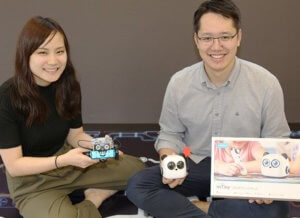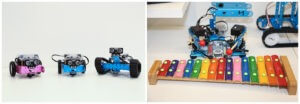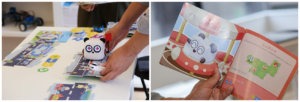
On the left is Mami Higashino, who is responsible for marketing and public relations, and was previously working at the venture capital, “500 Startups Japan” to create an entrepreneurial community. She fell in love with the Shenzhen startup community and joined Makeblock.
I still remember the toys which I played when I was a child. I like LEGO and diamond blocks, remember to enjoy making various combinations, and also remember that I was immersed in Plarail to create my own city.
“Makeblock” from Shenzhen, China may be one of those memorable toys for future children. They can help you learn the basics of coding by building your favorite parts and programming the motion of robots.
This time, I interviewed Hiroshi Kikuchi, on the right of the picture, the Country Manager of the Japanese branch. After working at Google for Education as Japan Vice President, he worked as a business manager at Sony Global Education for KOOV, a robot programming teaching tool. He also serves as a director of NPO Collable and CIO of Sapporo Shinyo High School.
The first coding robot for kids
— Could you tell me the origin of Makeblock?
Kikuchi: Makeblock was founded in 2013, by CEO Wang Jianjun in Shenzhen. Currently, there are about 600 employees worldwide and the business has four cornerstones: hardware, software, content, and competition. At first, we developed “mBot” to learn robotics and programming together, then programmable drone and programming kit for preschoolers, and then digital fabrication hardware such as laser cutter to make it easier for children to create things.
— Mr. Kikuchi, What kind of career did you go through before joining Makeblock?
Kikuchi: When I was a student, I majored in educational engineering and studied how to make education more efficient through the internet and digital devices and what can motivate students. In university days, I helped to set up Google’s education business (G Suite for Education). Later I was responsible for business in Japan. After I joined Sony Global Education which developed robot programming learning kit “KOOV”, and also operated worldwide Arithmetic Tournament. Next, I chose to join Makeblock.
— Do you think you are more interested in “teaching” or “creating tools and mechanisms for teaching”?
Kikuchi: I used to be a university teacher, so both. I am into tool-making because I want more people to use it to change the way we live and learn. Being a teacher is a great job, but only the students who are taught directly can be influenced. I want to work in a way that can affect 100 million people or even more. Even though, I may still become a teacher five years later again(laughs).
In addition to working at Makeblock, I am also working as a CIO at Sapporo Shinyo High School, and I am also helping to create an environment that uses IT to promote student learning. While doing various things, the axis is in Makeblock.
— Could you tell me about the 4 types of hardware, software, content, and competition that Makeblock provides?
Kikuchi: First, regarding hardware, our most famous programming robot kit is the “mBot” series. The mBot series that made Makeblock famous. They are made of aluminum with many expansion parts, so you can make various operations from ideas. For example, you could put a mallet on your arm and hit a xylophone (laughs).

— When you look at the rubber bands attached to the arm parts, you can also feel analog in a good way (laughs).
Kikuchi: That’s right (laughs). Not everything needs to be handled with the latest technology, and there is a desire to cultivate creativity by testing various ideas, either digital or analog.
In addition, we sell not only robots but also products consisting of more than 30 electronic modules such as the “Neuron” which contests of a sound sensor, light sensor, and human sensor (infrared sensor). They are also magnetically attached to each other, and it is a tool that makes it easy to learn the mechanism of IoT through actions such as flashing when a button is pressed and buzzer sounding when a hand is held over a sensor. You can combine it with Lego blocks too.
“mBlock”, that can be visually programmed across multiple products
— How do you program these products?
Kikuchi: When programming, it is often necessary to use the software associated with products such as “Software A for this, that needs Software B”, but we straddle multiple products with a software called “mBlock”, developed for visual programming. Each instruction such as “Make XX run for leap second” is like a block, and it can be executed by dragging and dropping the blocks together. You can rewrite this in Python (programming language).
mBot uses Arduino, an open-source platform for electronic work such as Raspberry Pi, and the programming language is based on C / C ++ language, so it is easy to get serious and full-fledged. It also supports children who want to take the first step in programming.
— This is similar to the Pepper programming tool (Choregraphe).
Kikuchi: mBlock is strongly influenced by the most famous system for learning the programming language “Scratch”, so it may be similar in terms of a visual programming platform. Scratch is a language for moving animations on a PC, but in the case of Makeblock, the main difference is that you start by assembling the kit yourself.
— I see. However, for children, you have something like a learning program, right?
Kikuchi: Yes. I don’t know how children can learn just by hardware, so I developed various teaching materials. There are about 30 teaching material development departments called “STEM Education Center” in Shenzhen. For example, we have prepared a program designed to explain how to teach in a one-hour class. The new product “mTiny” released in October is for infants over 4 years old, and it includes a card that commands operation and a map panel. No programming software is required and it feels like a puzzle. You can learn to give commands and move a robot.

The map below mTiny has a mechanism that works in conjunction with the contents of the picture. Each function works like a story in a picture book that kids can learn. mTiny’s lesson book, which children can playback the task contents by voice when touching with the tap pen that also functions as the main body controller
International robotics competition once a year to gather children worldwide
— So far, we have talked about hardware, software and content. Regarding competition, what are you holding?
Kikuchi: Every December in Shenzhen and Guangzhou, a global tournament called MakeX is held, and this year about 60 countries participated since STEM education domain is difficult to assess learning. For example, the results of national language and arithmetic can be measured by paper tests. However, there is no equal technology and creativity just because you can memorize functions and code. The competition is positioned to evaluate that.
— What do participants compete for in the tournament?
Kikuchi: Each year we will give different tasks and for teams to compete for the score. This year’s theme was “City Guardian”. There were different areas of red and blue on the map, and two people competed in a battle format. Competitions were based on themes such as “demolition of an aging power plant” and “obstacle removal”, which was programmed and executed in advance to execute pre-announced commands. The “automatic stage” and the two teams jointly moved the robot on the spot to compete for the total of the two score points of the “manual stage” that captures the mission.
For example, there was a mission called “Waste Separation”, but a sensor that identifies colors was used to clean up. Since mBot can also be equipped with arms, it can also be used to “plant trees”. After that, the thermal power plant was defeated because it was not good for the environment (laughs). There was also a task where you won’t earn points unless your opponents cooperate with you.
How children who learned programming would unleash their creativity when they grow up
— In Japan, the Shenzhen boom arrived in 2018. “Shenzhen is so vibrant and entrepreneurship is increasing, what is Japan doing?” There were lots of articles like the reverse version of “Japan is Great”, but how do you see Shenzhen, Mr. Kikuchi?
Kikuchi: It is often said that engineers and talents are plenty enough and there is an ecosystem, so the speed of creating prototypes is overwhelming. It’s a great environment for a hardware company.
— Is there any difference in programming education between children in China and Japan?
Kikuchi: China is a big country-driven project. Especially in Beijing, Shanghai and Shenzhen. For making things, using 3D printers instead of clay has a high affinity for technology. However, there are good and bad aspects. In Japan, the OECD Student Achievement Survey (PISA), a scholastic ability test for a 15-year-old student in a member country, will always enter TOP3 in mathematics and science. Although it is an analog education, the literacy rate is high, and it is still possible in all countries to multiply all math. Although it is not very strong in technology, there are good points like that.
— What are Makeblock plans for in the future?
Kikuchi: In FY2020, programming will be required at elementary schools, and we want to be able to enter the market. After that, it has been decided that programming education will be incorporated by changing the teaching guidelines of junior high school in 2021, or that programming will be adopted for the university entrance examination in 2024, and people who got advanced education in Japan become involved in programming in any way. So we would like to release products and services that can be involved there.
— Is there any specific strategy that moves like this?
Kikuchi: I want more programming education and manufacturer education to spread throughout the world. Therefore, we would like to be able to firmly deliver the tool not only to school education but also to educational facilities outside schools such as general consumer users and cram schools.
— The current generation, who are around 30 years old now, starts to work more in the middle and high school, so people with knowledge of HTML and CSS regardless of gender is quite advantageous for actual work. However, the children who played with Makeblock products seem to play an active role. “Programming? I did it a long time ago” (laughs).
Kikuchi: I understand because I am in the same generation (laughs). Today’s children are even more terrific, and it’s natural to go to a programming class to make an iPhone app yourself or make 3D modeling with Unity.
— So you want to have a common experience like “I played with LEGO blocks when I was a kid” in the future, “I played with Makeblock products”. It was only recently that I was surprised by the phenomenon that Minecraft is popular among children, and it seems to have spread not only as a solid image of “education” but also as entertainment like for example Mini 4WD.
Kikuchi: I want to make that happen. Now, my 3 years old child is playing with mTiny, so I’m looking forward to future growth (laughs). Makeblock’s vision is that it can support the implementation and movement of the image that comes to mind. It is often said that the 21st century is an era of creativity, but I would like to do my best as a company that can nurture such abilities.
(Writer) When I was an elementary student, I made a radio that could only be assembled with no experience. The cause was that the soldering was not good and the electronic circuit was damaged by heat. It was a bitter experience to lose confidence, though I should have recreated it without thinking about it.
What I’m doing now is writing web service code and testing it every day. Manufacturing is an activity based on daily failures. It will be continued again because there is an impression when moving. If there are educational materials that can be learned happily, the number of people who come across frustrations in manufacturing will decrease, and the proportion of people who create new values that have never existed will increase. I feel that the people who contributed there have dreams. I want adults to experience this enthusiasm.
Original interview: https://finders.me/articles.php?id=1483
Please note that this interview on FINDERS was translated and cut down based on the original version.